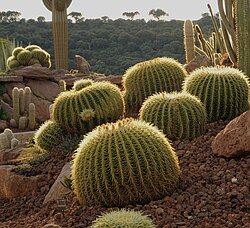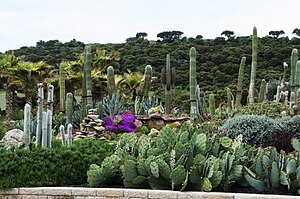Desert City
This article has multiple issues. Please help or discuss these issues on the talk page. (Learn how and when to remove these template messages)
|
| Desert City | |
|---|---|
 Echinocactus grusonii specimens in Desert City. | |
 | |
 | |
| Type | Botanical garden |
| Location | San Sebastián de los Reyes, Community of Madrid Spain. |
| Nearest town | , Madrid |
| Coordinates | 40°35′56″N 3°34′56.6″W / 40.59889°N 3.582389°WCoordinates: 40°35′56″N 3°34′56.6″W / 40.59889°N 3.582389°W |
| Area | 16,000 m² nursery and 6000 m² botanical garden |
| Created | April 28, 2017 |
| Owned by | private |
| Operated by | private |
| Status | Open all year |
| Website | desertcity |
Desert City is a plant nursery and botanical garden located in Madrid, Spain that specializes in the cultivation and sale of xerophytic plants. Desert City has over 600 species, including cacti, succulents, and native plants of the Mediterranean region.[1] It is Europe’s largest cactus garden.[2][3] Desert City's greenhouses and gardens have been awarded numerous awards for architectural design.[4] [5]
History[]
Desert City is the brain-child of Jacobo García-Germán, an Madrileño architect, and Mercedes García, a former pharmaceuticals executive.[6] García-Germán, García, and a dedicated team worked together to create the biotechnological nursery specialized in xeriscaping.[7] The garden is well-equipped for conducting research, cultivating plants, and increasing and disseminating education regarding cacti and other xerophytic plants. Tourists can enjoy a large botanical garden of about 6000 m², with more than 600 species, including plants native to the Community of Madrid. [1]
The garden[]

The garden combines the aesthetic elements of the natural landscapes of the arid and semi-arid areas of the planet such as cacti with native plants of a Mediterranean climate, like lavender, rosemary and others. It vast collection includes tiny Blossfeldia liliputana, which stands just 12-16 mm, and giant Saguaro, which stands nearly 50 feet in height. It is literally cacti museum.[8] The garden is divided into 5 main thematic areas:[1]
- Arizona, is the center of attention of the public eye. Highlights of this garden are cacti of various shapes, colors and textures assembled in a harmonious set. Three hills dominate this space, culminating at its apex with columnar-type cacti of different species and origins.
- Oasis, a recreational environment that welcomes the desert walker in search of refuge. The palm forest, the birds nesting in their canopies and the water sliding down the stones offer delight and relaxation. All exhibition elements have been designed to create atmosphere of seclusion.
- Taverns, a minimalist space that breaks with the organic aesthetics of the rest of the garden. The orthogonal line of water limits the garden space and creates a transitional link between the two design concepts. Cleistocactus, Echinopsis, Cephalocereus and other small xerophytes contrast with the black ground cover. The reflections of the plants in the polished sheets of cover provide fugitive effects of light at dawn. The mysticism of the golden ratio designed to intrigue the tourists on the walkway and adds symbolism to this welcoming space.
- Tuscany, is a reinterpretation of the Italian stately garden. In it species, associated with Italy, such as olive, pomegranate, myrtle, tamarix or lavender are mixed with others of Mexican origin such as yuccas, dasylirions, opuntias, agaves as well as many other species of varied origins. This space is characterized by the abundance and diversity of blooms, strong aromas and a singular beauty that produces the interbreeding of xerophytic species from different environments. Pale gravel, used as a cover, is complemented by the dark greens of the Mediterranean.
- Guajira, located under the walkway that crosses the garden, has a diversity of cacti, xerophytic Mediterranean species and plants popular in classic gardening.
Location[]
Desert City is located on the A1 highway, km 25, service road towards Madrid. In San Sebastián de los Reyes, Community of Madrid Spain.
Its opening hours during the winter months are Monday to Friday from 10:00 a.m. to 7:00 p.m., Saturday, Sunday and holidays from 10:00 a.m. to 8:30 p.m. During the summer months it is from Monday to Friday from 10:00 a.m. to 8:00 p.m., Saturday, Sunday and holidays from 10:00 a.m. to 9:30 p.m.[1]
The botanical garden, freely accessible, has an indicated and accessible route designed to accommodate the visit of individuals and guided visits of schools, town halls or institutions. Free guided tours are held in the garden on weekends and holidays (11:00 am, 12:00 pm and 1:00 pm). Tour reservations are available via email.[9]
See also[]
References[]
- ^ a b c d Desert City Madrid Destino Cultura Turismo y Negocio S. A.
- ^ Teddy Minford New ‘Desert City’ in Madrid Has Over 400 Species of Cactus Fodor's August 8, 2017
- ^ Reid, Siobhan (October 27, 2017). "8 Places to Feed Your Cactus Craze". .
- ^ XIV BEAU Bienal Española de Arquitectura y Urbanismo 2018 Prize, Fuera de Serie Prize 2017, Finalist FAD Prize 2018. Desert City GarciaGerman Arquitectos
- ^ (in Spanish) La mejor arquitectura española se muestra en Santander Bienal Española de Arquitectura y Urbanismo (BEAU)
- ^ Melkon Charchoglyan Prickly clients Monocle. Issue 118. November 2018
- ^ Elizabeth Caldwell With xeriscaping, grass needn't always be greener USA Today 2007-07-15.
- ^ Maria Cook Spain's Unique 'Desert City' Brings Cacti To Urban Madrid Green Matters. May 24, 2019
- ^ Desert City Tripadvisor
External links[]
| Look up Xeriscape in Wiktionary, the free dictionary. |
- The natural environment of San Sebastián de los Reyes.
- Ibero-Macaronesian Association of Botanical Gardens
- Botanical gardens page of Spain
- Xeriscape Colorado
- City of Albuquerque
- Texas Agricultural Extension Service
- Southern Nevada Water Authority
- Colorado State University Cooperative Extension
- Center for the Study of the Built Environment's Water-Conserving Landscapes Project
- Botanical gardens in Spain
- Cactus gardens
- 2017 establishments in Spain
- San Sebastián de los Reyes

